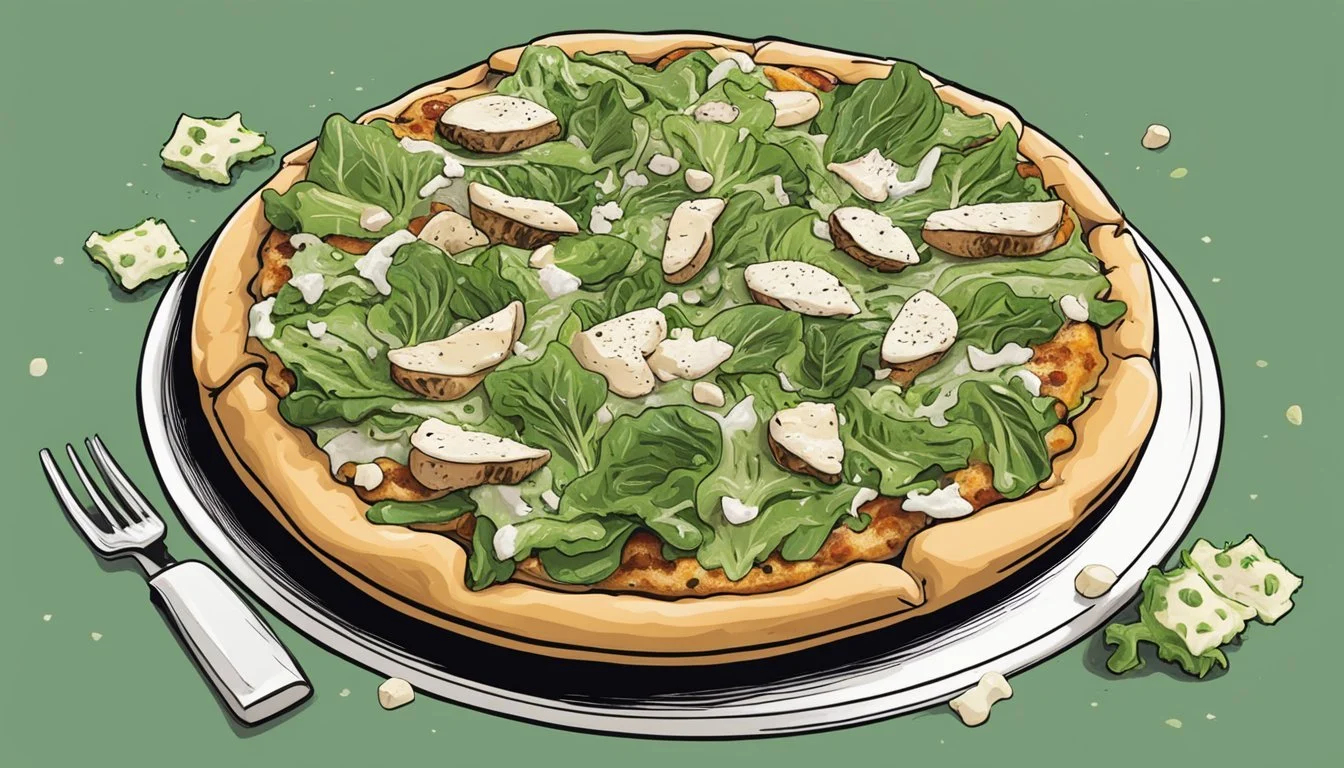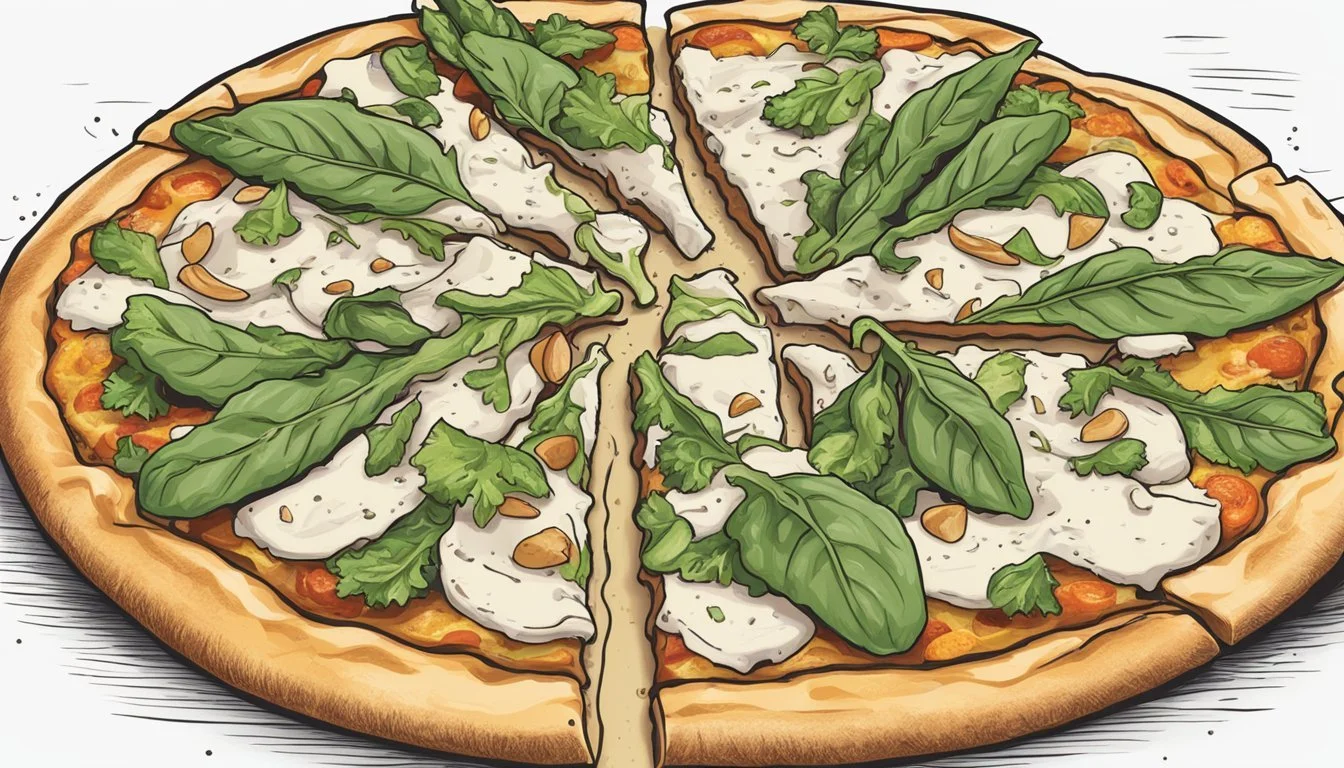Is Chicken Caesar Pizza Vegan?
Unraveling the Ingredients
Traditional chicken Caesar pizza (What wine goes well with pizza?) combines the savory flavors of Caesar salad with the hearty canvas of pizza. This dish typically features a crust topped with Caesar dressing, cheese, chicken, and sometimes additional salad components like romaine lettuce and croutons. Given the classic ingredients—chicken, cheese, and often anchovy-containing Caesar dressing—it is clear that standard chicken Caesar pizza is not vegan.
However, the evolving culinary landscape has seen a rise in plant-based substitutions that can mimic the flavors and textures of non-vegan foods. Enterprising chefs and home cooks have crafted vegan versions of chicken Caesar pizza using ingredients like vegan cheeses, plant-based chicken alternatives, and dressings made from cashews or tofu to emulate the creamy texture of traditional Caesar. These innovative solutions provide an experience that allows vegans to enjoy a pizza with the essence of a chicken Caesar salad without compromising their dietary preferences.
The availability of vegan chicken Caesar pizza largely depends on the creativity of the recipe and the adaptability of the cook. Replacing animal-derived products with plant-based options, while maintaining the integrity of the original dish, signifies a paradigm shift in contemporary cuisine that caters to the growing demand for vegan-friendly options. Vegan chicken Caesar pizza, when done correctly, delivers a culinary experience both familiar and new, fusing tradition with progressive food practices.
Understanding Veganism
In exploring the concept of veganism, it is important to outline what it entails, its benefits, and correct common misconceptions.
Defining Vegan
A vegan is an individual who abstains from consuming animal products, including meat, dairy, eggs, and honey. Veganism extends beyond dietary choices, embodying a philosophy that opposes the commodification of animals. Nutritional information is crucial for vegans to ensure they receive a balanced diet, often seeking plant-based alternatives to fulfill their dietary needs.
Benefits of Vegan Eating
A vegan diet can offer numerous health benefits when carefully planned. Here are key advantages:
Reduced risk of chronic diseases: A plant-based diet is often rich in fiber, vitamins, and antioxidants, lending itself to a reduced risk of conditions such as heart disease and type 2 diabetes.
Weight management: Vegan meals are typically lower in calories and fats compared to animal-based foods, facilitating weight management.
Environmental impact: Vegan diets tend to have a lower carbon footprint, contributing less to climate change and environmental degradation.
Common Misconceptions about Veganism
Despite its growing popularity, veganism is often subject to misunderstandings:
Myth: Vegans do not get enough protein. Vegans can obtain adequate protein from plant sources like beans, lentils, tofu, and quinoa.
Myth: Vegan diets are not suitable for athletes. Numerous athletes maintain peak performance on a vegan diet, supplemented with tailored nutrition plans.
By considering these aspects, individuals can gain a thorough understanding of veganism, its principles, and the lifestyle it promotes.
Components of a Chicken Caesar Pizza
When constructing a Chicken Caesar Pizza, the choice of ingredients directly influences whether the dish is vegan. Traditional recipes utilize a myriad of animal-based products, while vegan versions incorporate plant-based substitutes to replicate the flavors and textures.
Typical Ingredients in Chicken Caesar Pizza
To make a conventional Chicken Caesar Pizza, the recipe consists of the following ingredients:
Dough: Typically made from flour, water, yeast, and salt.
Caesar dressing: A blend of mayonnaise, olive oil, lemon juice, Parmesan cheese, garlic, anchovies (What wine goes well with anchovies?) (sometimes), mustard, and Worcestershire sauce.
Chicken: Cooked and sliced or shredded, often seasoned.
Cheese: Usually shredded Parmesan and sometimes mozzarella.
Lettuce: Romaine lettuce is the standard, providing a fresh, crunchy element.
Pepper: Freshly ground black pepper adds a slight heat.
Croutons: Oven-baked seasoned bread cubes for crunch.
Analysis of Non-Vegan Ingredients
The non-vegan elements within a Chicken Caesar Pizza include:
Chicken: As the primary protein source and a meat product, chicken is not vegan.
Cheese: Both Parmesan and mozzarella are dairy products derived from milk.
Caesar dressing: Traditionally contains anchovies, Parmesan cheese, and mayonnaise made with eggs.
Croutons: Often prepared with butter or other dairy products.
Vegan Substitutes for Traditional Ingredients
To create a vegan Chicken Caesar Pizza, chefs adapt the recipe using these substitutes:
Vegan chicken: Plant-based alternatives like tofu, tempeh (What wine goes well with tempeh?), or seitan (What wine goes well with seitan?) can mimic chicken.
Vegan cheese: Nutritional yeast, soy-based or other plant-based cheeses replace Parmesan and mozzarella.
Vegan Caesar dressing: Ingredients such as vegan mayo, capers, (What wine goes well with capers?) and vegan Parmesan provide a similar flavor profile without animal products.
Vegan croutons: Croutons can be made with vegan bread and oil rather than butter.
This adaptation of the recipe ensures that the pizza retains the characteristic flavors of a Chicken Caesar Pizza while complying with vegan dietary standards.
Creating a Vegan Pizza Base
Crafting a vegan pizza base involves careful selection of ingredients and baking methods to ensure the result is both delicious and plant-based. This section provides guidance on choosing the right pizza dough, preparing the crust, as well as offering baking tips for the perfect vegan pizza, including gluten-free options.
Selecting the Right Pizza Dough
When creating a vegan pizza base, it is vital to start with pizza dough that is free of animal products. Traditional pizza dough is typically vegan, containing flour, water, yeast, salt, and sometimes sugar and oil. However, it is important to read ingredient labels or confirm with the manufacturer as some pre-made doughs may contain dairy or eggs. For a homemade dough, one can mix high-quality flour with the other vegan ingredients, following a trusted recipe.
Preparing the Pizza Crust
Once the dough is ready, the next step is to prepare the pizza crust. She needs to shape the dough on a surface lightly dusted with flour to prevent sticking. Then, the baker transfers the dough to a baking sheet lined with parchment paper. It is essential not to overwork the dough, which keeps it light and airy.
Vegan Baking Techniques and Tips
Baking a vegan pizza requires some adjustments to ensure the crust is crispy and golden brown. Preheating the oven to a high temperature, typically around 450-500°F (232-260°C), is crucial. For those using an air fryer, the cook time will be shorter, so one must keep a close eye on the pizza. It is helpful to use a pizza stone or a preheated baking sheet to mimic the effect of a pizza oven, providing an evenly cooked base.
Gluten-Free Vegan Pizza Options
For individuals with gluten sensitivities, a gluten-free vegan pizza base is a necessity. She can buy or make gluten-free pizza dough using various gluten-free flours such as almond, rice, or chickpea flour. When preparing the crust on a baking sheet, it's often beneficial to bake the crust for a short time before adding toppings, ensuring that it doesn't become soggy. Ensuring the oven is properly calibrated for the delicate nature of gluten-free dough is also important for achieving the right texture.
Vegan Cheese Alternatives
Vegan cheese alternatives offer plant-based renditions that capture the essence of traditional cheese flavors without any animal products. These alternatives come in various bases like nuts and soy, allowing for both homemade and commercially available options to accommodate vegan diets.
Cashew-Based Vegan Cheese
Cashew-based vegan cheese is a popular choice for its creamy texture and mild flavor. A recipe typically entails blending cashews with nutritional yeast, water, lemon juice, and seasonings to achieve a cheese-like consistency. Variations might include vegan parmesan or vegan mozzarella shreds to complement a dish like vegan Caesar salad pizza.
Soy and Nut-Free Vegan Cheese Options
For individuals with nut allergies, soy and other nut-free alternatives are accessible. Tofu can serve as a base for vegan cheese, providing a soy-based option that's rich in protein. It's blended with ingredients such as nutritional yeast, seasonings, and water to create a spreadable or meltable cheese alternative.
Commercial Vegan Cheese Brands
Commercial vegan cheeses are readily available and often include ingredients like tapioca starch and coconut oil to replicate the melt and stretch of traditional cheese. Brands like Kite Hill offer almond milk-based cheeses while others might utilize a blend of vegetable oils and starches for nut-free vegan cheese options.
Homemade Vegan Cheese Recipes
Creating vegan cheese at home allows for full control over the ingredients and flavors. Basic recipes involve blending soaked cashews or tofu with nutritional yeast for umami flavor, water for desired consistency, and other seasonings. Homemade vegan cheeses can be tailored to specific dishes, from spreadable to meltable versions, suitable for pizza toppings (What wine goes well with pizza toppings?) or creamy dressings.
Non-Dairy Caesar Dressing Variations
Creating a vegan version of Caesar dressing is simple and can yield an array of flavorful, creamy dressings that satisfy the palate without the use of dairy products. These non-dairy variations typically utilize ingredients such as cashews, tahini, and plant-based mayonnaise as bases, which are then flavored with garlic, lemon juice, Dijon mustard, and other seasonings.
Homemade Vegan Caesar Dressing
The foundation of a homemade vegan Caesar dressing typically involves raw cashews or tahini. Cashews, when soaked and blended, give a creamy texture, while tahini, which is sesame paste, offers a rich, nutty flavor. Lemon juice and Dijon mustard add tanginess and depth, while garlic powder provides the essential garlic kick characteristic of Caesar dressing. To achieve the desired consistency and add a subtle piquancy, some recipes also include apple cider vinegar. Here’s a brief recipe construct:
Blend: Soaked cashews or tahini with lemon juice, Dijon mustard, garlic powder, and olive oil.
Adjust: Add water or apple cider vinegar to achieve a pourable dressing consistency.
Season: With salt and pepper to taste.
Store-Bought Vegan Caesar Alternatives
For those who prefer convenience, store-bought vegan Caesar alternatives are also available. These products are designed to mimic the classic Caesar flavor while being completely plant-based. When selecting a store-bought dressing, consumers should look for key vegan ingredients like:
Ingredients Purpose Plant-based mayonnaise Creaminess Nutritional yeast Cheesy flavor Soy or coconut aminos Umami depth Sea vegetables Fish-free “anchovy” flavor
Read labels carefully to ensure that the product aligns with vegan standards and doesn't contain any animal-derived ingredients.
Alternative Vegan Protein Sources
When seeking to replicate the savory taste and satisfying texture of chicken Caesar pizza, there are a plethora of plant-based protein options available that not only mimic the characteristics of chicken but also provide a healthful and ethical alternative.
Tofu as a Chicken Substitute
Tofu, with its neutral flavor and versatile texture, is a staple in vegan cuisine for its ability to absorb a multitude of flavors, including the zesty tang crucial to Caesar salad. Rich in protein, tofu can be seasoned with garlic powder, onion powder, and smoked paprika to mimic the taste profile of chicken. Sliced into thin pieces, tofu provides the perfect bite when atop a Caesar pizza.
Using Tempeh or Seitan
For a heartier bite, tempeh and seitan appear as excellent substitutes for chicken. Tempeh, with its firm texture and nutty flavor, is made from fermented soybeans and blends seamlessly into a Caesar milieu when marinated. Seitan, often known as wheat meat, offers a chewy texture that can remind one of chicken's fibrous threads. Both can be enhanced with nutritional yeast for a savory, cheese-like flavor.
Experimenting with Vegan Meat Alternatives
Many vegan meat alternatives crafted specifically as chicken replacements can be found commercially. These products are often designed to replicate the texture of chicken and come seasoned or unseasoned, allowing for personal culinary creativity. Vegan chicken strips or pieces can be especially convincing in dishes like Caesar pizza, with some even offering a smoky edge akin to vegan bacon.
Marinating and Preparing Vegan Proteins
Effective use of marinades and preparation techniques can elevate the flavor of vegan proteins to new heights. Typically, a marinade with olive oil, water and a mix of spices can deeply infuse vegan proteins with robust flavors. Marinating these proteins helps to soften and enhance their texture, making them a delightful topping for any vegan take on a traditionally non-vegan dish such as chicken Caesar pizza.
Toppings and Additions for Flavor
Crafting a delectable vegan Chicken Caesar Pizza hinges on the selection of toppings that satisfy traditional flavors while adhering to vegan standards.
Selecting Vegan-Friendly Toppings
When choosing toppings for a vegan Chicken Caesar Pizza, ensure they are devoid of animal products. Romaine lettuce and kale provide the classic Caesar salad base, while vegan parmesan and vegan bacon replicate the traditional tastes. Consider adding thinly sliced red onions and black olives for additional depth and texture.
Creating a Balanced Flavor Profile
A balanced flavor profile on a vegan pizza requires attention to the blend of salty, savory, and fresh elements. Capitalize on capers and a pinch of black pepper to introduce a briny kick. For a gentle zest, incorporate fresh parsley and a hint of dried parsley. Garlic and salt, when used modestly, accentuate the overall taste harmoniously.
Innovative Vegan Toppings for Pizza
Embrace innovation with toppings like smashed avocado for creaminess or marinated mushrooms to replace traditional meats. Use vegan parmesan liberally and consider vegan Caesar dressing drizzles post-baking. Experimenting with crisp romaine lettuce or even grilled romaine hearts can offer an exciting texture contrast.
Garnishes and Final Touches
Garnishes elevate the final presentation and taste. After baking, top the pizza with fresh romaine and dashes of freshly ground black pepper. A finishing drizzle of high-quality olive oil adds richness and sheen, and a sprinkle of fresh or dried parsley can brighten the final dish.
Pizza Assembly and Baking Instructions
Assembling and baking a pizza requires careful layering of ingredients and precise oven management to ensure a perfectly cooked result. Here's how to do it for a delicious vegan Caesar salad pizza.
Layering Ingredients for an Optimal Bake
For a vegan Caesar salad pizza, begin by spreading the vegan Caesar dressing evenly over the pre-baked pizza crust, leaving a small border for the crust. Next, evenly distribute the vegan cheese shreds across the pizza. If using vegan chicken, scatter it over the cheese. Prepare a baking sheet by dusting it lightly with flour to prevent sticking.
Baking Temperature and Duration
The oven should be preheated to a temperature of 425°F (220°C), which allows for a crispy crust without burning the toppings. Place the pizza directly on the oven rack or on a preheated baking sheet for a crispier bottom. The baking duration typically ranges from 12 to 15 minutes.
Checking for Doneness and Quality
He or she should monitor the pizza's edges, which should be golden brown, and the vegan cheese, which should be melted and possibly lightly browned. The vegan chicken should be heated through and slightly crisp.
Serving Suggestions and Presentation
Once the vegan Caesar salad pizza is baked, top it with fresh salad greens before slicing. Serving it immediately ensures the salad remains crisp. For an Instagram-worthy presentation, garnish with a sprinkle of vegan Parmesan or a drizzle of vegan Caesar dressing.
Making a Vegan Caesar Salad Pizza Wrap
To make a wrap, spread vegan Caesar dressing over a large flour tortilla. Add vegan cheese, vegan chicken, and salad greens. Place a slice of the baked vegan Caesar salad pizza on top, fold in the sides of the tortilla, and roll it tightly to secure the contents. Toast the wrap in a pan to make it crispy on the outside before serving.
Nutritional Considerations and Benefits
When evaluating the nutritional landscape of vegan Chicken Caesar Pizza, it is crucial to take a comprehensive look at the caloric content and macro-nutrient distribution. A vegan version of this classic pizza offers a distinct nutritional profile that is influenced by plant-based ingredients which can contribute to an individual's health goals.
Caloric and Macronutrient Breakdown
Calories:
A typical slice of vegan Chicken Caesar Salad Pizza contains approximately 170 calories.
Macronutrients:
Protein: Plant-based chicken substitutes, often made from soy or wheat protein, provide a source of protein that is comparable to real chicken, contributing to muscle maintenance and growth.
Fats: Vegan pizzas generally contain less saturated fat due to the exclusion of cheese and meat, instead utilizing ingredients like cashews and vegan mayonnaise that provide healthier fat varieties.
Carbohydrates: The crust and dough represent the primary source of carbohydrates, offering energy throughout the day.
Additional Nutrients:
This pizza may also offer a good supply of dietary fiber from wholegrain crust options and additional vitamins and minerals from toppings such as leafy greens and fortified vegan cheese alternatives.
It's important for enthusiasts to consider such a profile to understand how vegan Chicken Caesar Pizza can fit into a balanced diet.
Storage and Reheating Tips
To maintain the freshness and quality of chicken Caesar pizza that is vegan, one should be mindful of proper storage techniques and reheating methods to preserve its taste and texture.
Proper Storage for Leftovers
When storing leftover vegan chicken Caesar pizza, it's crucial to let the pizza cool down to prevent condensation that can lead to sogginess. Once cooled:
Wrap it tightly: Use plastic wrap or aluminum foil to cover the pizza slices, ensuring minimal air exposure.
Refrigerator storage: Place wrapped slices in an airtight container. Store in the refrigerator for up to 2-3 days.
Freezer option: For longer storage, the slices can be frozen. Use a layer of plastic wrap followed by a layer of foil to wrap each piece individually. Store in the freezer for up to 1 month.
Methods for Reheating Vegan Pizza
To reheat a slice of vegan chicken Caesar pizza and attain an enjoyable texture and temperature:
Oven Reheating:
Preheat the oven to 375°F (190°C).
Place the slices on a baking sheet or directly onto the oven rack for a crisper bottom.
Heat for about 10 minutes or until thoroughly warm and cheese has re-melted.
Air Fryer Reheating:
Set the air fryer to 350°F (175°C).
Arrange the pizza slices in a single layer.
Reheat for 3-6 minutes, checking frequently.
Microwave (Not Recommended):
Although quick, reheating in a microwave may lead to a soggy crust.
If necessary, use a microwave-safe plate and heat on low power in short intervals of 30 seconds, checking between intervals.
Using these methods and tips, one can enjoy their leftover vegan chicken Caesar pizza almost as if it were freshly made.
FAQs on Vegan Chicken Caesar Pizza
When crafting a vegan Chicken Caesar Pizza, one must consider both the ingredients and preparation methods to ensure that the final product remains true to vegan dietary standards. It often involves substituting traditional pizza toppings with plant-based alternatives.
Common Questions Addressed
Is traditional Chicken Caesar Pizza vegan?
No, traditional Chicken Caesar Pizza typically contains chicken and cheese which are not vegan-friendly ingredients.
What constitutes a vegan Chicken Caesar Pizza?
A vegan Chicken Caesar Pizza replaces chicken with plant-based proteins like vegan chicken or tofu and uses dairy-free cheese and Caesar dressing.
Can vegan Chicken Caesar Pizza taste as good as the traditional one?
Absolutely. With the right combination of ingredients and seasonings, a vegan Chicken Caesar Pizza can be equally delicious.
Where can I find vegan Caesar dressing?
Vegan Caesar dressing can be bought from stores that carry vegan products or made at home using ingredients such as cashews, garlic, lemon juice, vegan mayonnaise, and capers.
Are there restaurant options for vegan Chicken Caesar Pizza?
Yes, some pizzerias and restaurants have begun offering vegan pizza options, including vegan Chicken Caesar Pizza varieties.
Tips for First-Time Vegan Pizza Makers
Select the right base: Start with a vegan pizza dough; store-bought or homemade will work.
Choose your protein: Opt for plant-based protein sources such as marinated tofu, tempeh, or commercially available vegan chicken alternatives.
Dairy-free is the way: Dairy-free cheese options are abundant and vary in taste and texture. Experiment to find one that melts well and complements your pizza.
Sauce it right: Homemade vegan Caesar dressing can elevate your pizza. Blending soaked cashews with garlic, lemon juice, capers, and vegan mayonnaise creates a creamy base akin to traditional Caesar.
Toppings can make or break it: Don't overlook the power of additional toppings like vegan parmesan, fresh romaine lettuce, and croutons for an authentic Caesar experience.
One should always ensure that all the individual ingredients used are certified vegan to align with dietary restrictions. It's important to read labels carefully or inquire at restaurants about their vegan options to ensure compliance.












